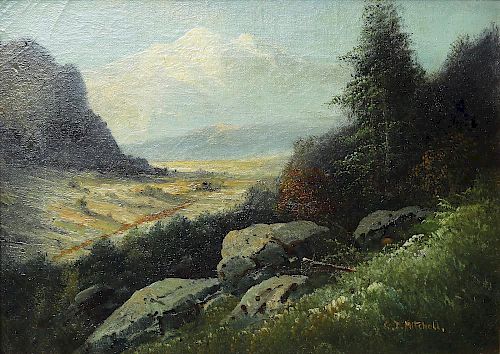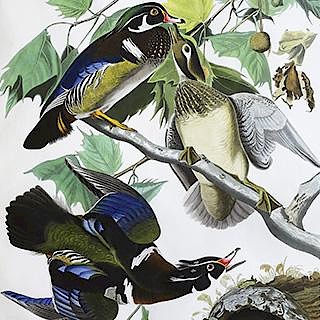C. T. Mitchell, View of Northern California Oil Painting
Lot 108
About Seller
Arader Galleries
1308 Walnut Street
King of Prussia, PA 19406
United States
Arader Galleries proudly celebrates over 40 years in the business of important, antique works on paper, paintings and rare books. W. Graham Arader III began his collection of rare maps, atlases and Americana while an undergraduate at Yale University, and today that passion has grown into one of the ...Read more
Categories
Estimate:
$1,000 - $2,000
Absentee vs Live bid
Two ways to bid:
- Leave a max absentee bid and the platform will bid on your behalf up to your maximum bid during the live auction.
- Bid live during the auction and your bids will be submitted real-time to the auctioneer.
Bid Increments
| Price | Bid Increment |
|---|---|
| $0 | $25 |
| $500 | $50 |
| $1,000 | $100 |
| $2,000 | $250 |
| $5,000 | $500 |
| $10,000 | $1,000 |
| $20,000 | $2,000 |
| $50,000 | $5,000 |
| $100,000 | $10,000 |
| $200,000 | $25,000 |
About Auction
By Arader Galleries
Jan 28, 2017 - Jan 29, 2017
Set Reminder
2017-01-28 13:00:00
2017-01-29 13:00:00
America/New_York
Bidsquare
Bidsquare : Arader Galleries Winter 2017 Auction
https://www.bidsquare.com/auctions/arader/arader-galleries-winter-2017-auction-2063
Arader Galleries loricohen@aradergalleries.com
Arader Galleries loricohen@aradergalleries.com
- Lot Description
A View of Mt. Shasta and the Black Butte, Northern California. C. T. Mitchell (American 19th / 20th Century). Signed "C. T. Mitchell" LR. Oil on Canvas. 10 x 14 inches canvas, 14 1/2 x 18 1/2 inches framed. This is a gorgeous painting of Mount Shasta and Black Butte by turn-of-the-century Northern Californian artist, C.T. Mitchell. From the viewer's elevated vantage point, he or she is also able to glimpse a portion of the legendary Siskiyou Trail leading up to the base of the famed stratovolcano. The Siskiyou Trail, which once spanned between California and Oregon, was an ancient trade route first laid out by pre-historical Native American tribes. In addition to depicting two of California's most esteemed natural wonders, Mitchell's sumptuously colored work provides detailed illustrations of Northern California's vast array of verdant, bountiful foliage and monumentally-sized trees. Following the discovery of gold in California in 1848, artist-prospectors began flocking to the once sparsely populated region. After failing to realize their fortunes, a number of these artists found work creating portraits and landscape scenes for the "Big Four" railroad barons and some of San Francisco's other new millionaires. By the 1880s, however, there grew a national demand for landscapes of California's greatest scenic wonders, including Mount Shasta. This demand no doubt explains why so many prominent landscape painters decided to establish studios in San Francisco during the same exciting time period. Such artists included Thomas Moran, Albert Bierstadt, Martin Johnson Heade, and James Hamilton. Northern Californian landscape painters often traveled into the rugged Sierra Nevada region on foot or horseback to make the sketches that would later serve as the basis of the "finished" landscape paintings they completed in their urban studios. This painting contains all of the elements of a "classic" Western landscape painting, a tradition that drew inspiration from the Eastern United States' Hudson River School, Germany's Düsseldorf School, and France's Barbizon School. For example, while Mitchell's work contains a vast amount of botanical and topographical detail, a trait typical of the Hudson River School, his overall painterly style is more consistent with European landscape traditions. Mount Shasta, a 14,179-foot stravolcano, is the second-highest peak in the Cascade Range and the fifth highest peak in California. It stands unconnected to any nearby mountain, rising sharply from the miles of level ground which enclose it. The distinctive mountain consists of four overlapping volcanic cones and contains seven named glaciers. Black Butte comprises of a number of overlapping lava dames, and is a parasitic satellite cone of Mount Shasta.
- Shipping Info
-
Shipping Terms:Packing and handling of purchased lots by us or by someone else is at the entire risk of the purchaser. Purchasers are responsible for all packing and shipping costs.
We are not responsible for the acts or omissions of carriers or packers of purchased lots whether or not recommended by us.
-
- Buyer's Premium



 EUR
EUR CAD
CAD AUD
AUD GBP
GBP MXN
MXN HKD
HKD CNY
CNY MYR
MYR SEK
SEK SGD
SGD CHF
CHF THB
THB




